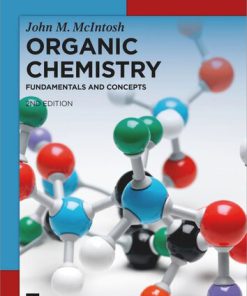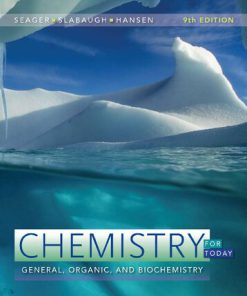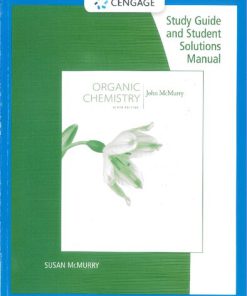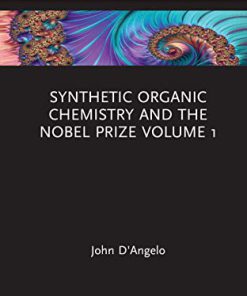Organic Chemistry 9th Edition by John Mcmurry ISBN 9781305080485 1305080483
$50.00 Original price was: $50.00.$25.00Current price is: $25.00.
Organic Chemistry 9th Edition by John Mcmurry – Ebook PDF Instant Download/Delivery: 9781305080485 ,1305080483
Full download Organic Chemistry 9th Edition after payment
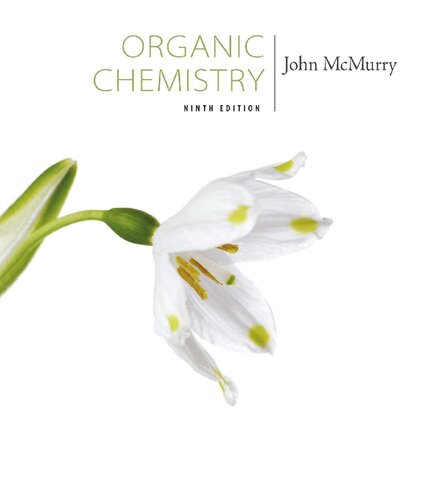
Product details:
ISBN 10: 1305080483
ISBN 13: 9781305080485
Author: John Mcmurry
Organic Chemistry 9th Edition Table of contents:
1. Structure and Bonding
1-1. Atomic Structure: The Nucleus
1-2. Atomic Structure: Orbitals
1-3. Atomic Structure: Electron Configurations
1-4. Development of Chemical Bonding Theory
1-5. Describing Chemical Bonds: Valence Bond Theory
1-6. sp 3 Hybrid Orbitals and the Structure of Methane
1-7. sp 3 Hybrid Orbitals and the Structure of Ethane
1-8. sp 2 Hybrid Orbitals and the Structure of Ethylene
1-9. sp Hybrid Orbitals and the Structure of Acetylene
1-10. Hybridization of Nitrogen, Oxygen, Phosphorus, and Sulfur
1-11. Describing Chemical Bonds: Molecular Orbital Theory
1-12. Drawing Chemical Structures
Something Extra. Organic Foods: Risk versus Benefit
Summary
Key Words
Exercises: Visualizing Chemistry
Exercises: Additional Problems
2. Polar Covalent Bonds; Acids and Bases
2-1. Polar Covalent Bonds: Electronegativity
2-2. Polar Covalent Bonds: Dipole Moments
2-3. Formal Charges
2-4. Resonance
2-5. Rules for Resonance Forms
2-6. Drawing Resonance Forms
2-7. Acids and Bases: The Brønsted–Lowry Definition
2-8. Acid and Base Strength
2-9. Predicting Acid–Base Reactions from p K a Values
2-10. Organic Acids and Organic Bases
Organic Acids
Organic Bases
2-11. Acids and Bases: The Lewis Definition
Lewis Acids and the Curved Arrow Formalism
Lewis Bases
2-12. Noncovalent Interactions between Molecules
Something Extra. Alkaloids: From Cocaine to Dental Anesthetics
Summary
Key Words
Exercises: Visualizing Chemistry
Exercises: Mechanism Problems
Exercises: Additional Problems
3. Organic Compounds: Alkanes and Their Stereochemistry
3-1. Functional Groups
Functional Groups with Carbon–Carbon Multiple Bonds
Functional Groups with Carbon Singly Bonded to an Electronegative Atom
Functional Groups with a Carbon–Oxygen Double Bond (Carbonyl Groups)
3-2. Alkanes and Alkane Isomers
3-3. Alkyl Groups
3-4. Naming Alkanes
3-5. Properties of Alkanes
3-6. Conformations of Ethane
3-7. Conformations of Other Alkanes
Something Extra. Gasoline
Summary
Key Words
Exercises: Visualizing Chemistry
Exercises: Additional Problems
4. Organic Compounds: Cycloalkanes and Their Stereochemistry
4-1. Naming Cycloalkanes
4-2. Cis–Trans Isomerism in Cycloalkanes
4-3. Stability of Cycloalkanes: Ring Strain
4-4. Conformations of Cycloalkanes
Cyclopropane
Cyclobutane
Cyclopentane
4-5. Conformations of Cyclohexane
4-6. Axial and Equatorial Bonds in Cyclohexane
4-7. Conformations of Monosubstituted Cyclohexanes
4-8. Conformations of Disubstituted Cyclohexanes
4-9. Conformations of Polycyclic Molecules
Something Extra. Molecular Mechanics
Summary
Key Words
Exercises: Visualizing Chemistry
Exercises: Additional Problems
5. Stereochemistry at Tetrahedral Centers
5-1. Enantiomers and the Tetrahedral Carbon
5-2. The Reason for Handedness in Molecules: Chirality
5-3. Optical Activity
5-4. Pasteur’s Discovery of Enantiomers
5-5. Sequence Rules for Specifying Configuration
5-6. Diastereomers
5-7. Meso Compounds
5-8. Racemic Mixtures and the Resolution of Enantiomers
5-9. A Review of Isomerism
5-10. Chirality at Nitrogen, Phosphorus, and Sulfur
5-11. Prochirality
5-12. Chirality in Nature and Chiral Environments
Something Extra. Chiral Drugs
Summary
Key Words
Exercises: Visualizing Chemistry
Exercises: Additional Problems
6. An Overview of Organic Reactions
6-1. Kinds of Organic Reactions
6-2. How Organic Reactions Occur: Mechanisms
6-3. Radical Reactions
6-4. Polar Reactions
6-5. An Example of a Polar Reaction: Addition of HBr to Ethylene
6-6. Using Curved Arrows in Polar Reaction Mechanisms
6-7. Describing a Reaction: Equilibria, Rates, and Energy Changes
6-8. Describing a Reaction: Bond Dissociation Energies
6-9. Describing a Reaction: Energy Diagrams and Transition States
6-10. Describing a Reaction: Intermediates
6-11. A Comparison between Biological Reactions and Laboratory Reactions
Something Extra. Where Do Drugs Come From?
Summary
Key Words
Exercises: Visualizing Chemistry
Exercises: Energy Diagrams and Reaction Mechanisms
Exercises: Additional Problems
Practice Your Scientific Analysis and Reasoning I
Practice Your Scientific Analysis and Reasoning I
7. Alkenes: Structure and Reactivity
7-1. Industrial Preparation and Use of Alkenes
7-2. Calculating Degree of Unsaturation
7-3. Naming Alkenes
7-4. Cis–Trans Isomerism in Alkenes
7-5. Alkene Stereochemistry and the E,Z Designation
7-6. Stability of Alkenes
7-7. Electrophilic Addition Reactions of Alkenes
7-8. Orientation of Electrophilic Additions: Markovnikov’s Rule
7-9. Carbocation Structure and Stability
7-10. The Hammond Postulate
7-11. Evidence for the Mechanism of Electrophilic Additions: Carbocation Rearrangements
Something Extra. Bioprospecting: Hunting for Natural Products
Summary
Key Words
Exercises: Visualizing Chemistry
Exercises: Mechanism Problems
Exercises: Additional Problems
8. Alkenes: Reactions and Synthesis
8-1. Preparing Alkenes: A Preview of Elimination Reactions
8-2. Halogenation of Alkenes: Addition of X 2
8-3. Halohydrins from Alkenes: Addition of HOX
8-4. Hydration of Alkenes: Addition of H 2 O by Oxymercuration
8-5. Hydration of Alkenes: Addition of H 2 O by Hydroboration
8-6. Reduction of Alkenes: Hydrogenation
8-7. Oxidation of Alkenes: Epoxidation and Hydroxylation
8-8. Oxidation of Alkenes: Cleavage to Carbonyl Compounds
8-9. Addition of Carbenes to Alkenes: Cyclopropane Synthesis
8-10. Radical Additions to Alkenes: Chain-Growth Polymers
8-11. Biological Additions of Radicals to Alkenes
8-12. Reaction Stereochemistry: Addition of H 2 O to an Achiral Alkene
8-13. Reaction Stereochemistry: Addition of H 2 O to a Chiral Alkene
Something Extra. Terpenes: Naturally Occurring Alkenes
Summary
Key Words
Summary of Reactions
Exercises: Visualizing Chemistry
Exercises: Mechanism Problems
Exercises: Additional Problems
9. Alkynes: An Introduction to Organic Synthesis
9-1. Naming Alkynes
9-2. Preparation of Alkynes: Elimination Reactions of Dihalides
9-3. Reactions of Alkynes: Addition of HX and X 2
9-4. Hydration of Alkynes
Mercury(II)-Catalyzed Hydration of Alkynes
Hydroboration–Oxidation of Alkynes
9-5. Reduction of Alkynes
9-6. Oxidative Cleavage of Alkynes
9-7. Alkyne Acidity: Formation of Acetylide Anions
9-8. Alkylation of Acetylide Anions
9-9. An Introduction to Organic Synthesis
Something Extra. The Art of Organic Synthesis
Summary
Key Words
Summary of Reactions
Exercises: Visualizing Chemistry
Exercises: Mechanism Problems
Exercises: Additional Problems
10. Organohalides
10-1. Names and Structures of Alkyl Halides
10-2. Preparing Alkyl Halides from Alkanes: Radical Halogenation
10-3. Preparing Alkyl Halides from Alkenes: Allylic Bromination
10-4. Stability of the Allyl Radical: Resonance Revisited
10-5. Preparing Alkyl Halides from Alcohols
10-6. Reactions of Alkyl Halides: Grignard Reagents
10-7. Organometallic Coupling Reactions
10-8. Oxidation and Reduction in Organic Chemistry
Something Extra. Naturally Occurring Organohalides
Summary
Key Words
Summary of Reactions
Exercises: Visualizing Chemistry
Exercises: Mechanism Problems
Exercises: Additional Problems
11. Reactions of Alkyl Halides: Nucleophilic Substitutions and Eliminations
11-1. The Discovery of Nucleophilic Substitution Reactions
11-2. The S N 2 Reaction
11-3. Characteristics of the S N 2 Reaction
The Substrate: Steric Effects in the S N 2 Reaction
The Nucleophile
The Leaving Group
The Solvent
A Summary of S N 2 Reaction Characteristics
11-4. The S N 1 Reaction
11-5. Characteristics of the S N 1 Reaction
The Substrate
The Leaving Group
The Nucleophile
The Solvent
A Summary of S N 1 Reaction Characteristics
11-6. Biological Substitution Reactions
11-7. Elimination Reactions: Zaitsev’s Rule
11-8. The E2 Reaction and the Deuterium Isotope Effect
11-9. The E2 Reaction and Cyclohexane Conformation
11-10. The E1 and E1cB Reactions
The E1 Reaction
The E1cB Reaction
11-11. Biological Elimination Reactions
11-12. A Summary of Reactivity: S N 1 , S N 2 , E1, E1cB, and E2
Something Extra. Green Chemistry
Summary
Key Words
Summary of Reactions
Exercises: Visualizing Chemistry
Exercises: Mechanism Problems
Exercises: Additional Problems
Practice Your Scientific Analysis and Reasoning II
Practice Your Scientific Analysis and Reasoning II
12. Structure Determination: Mass Spectrometry and Infrared Spectroscopy
12-1. Mass Spectrometry of Small Molecules: Magnetic-Sector Instruments
12-2. Interpreting Mass Spectra
12-3. Mass Spectrometry of Some Common Functional Groups
Alcohols
Amines
Halides
Carbonyl Compounds
12-4. Mass Spectrometry in Biological Chemistry: Time-of-Flight (TOF) Instruments
12-5. Spectroscopy and the Electromagnetic Spectrum
12-6. Infrared Spectroscopy
12-7. Interpreting Infrared Spectra
12-8. Infrared Spectra of Some Common Functional Groups
Alkanes
Alkenes
Alkynes
Aromatic Compounds
Alcohols
Amines
Carbonyl Compounds
Something Extra. X-Ray Crystallography
Summary
Key Words
Exercises: Visualizing Chemistry
Exercises: Additional Problems
13. Structure Determination: Nuclear Magnetic Resonance Spectroscopy
13-1. Nuclear Magnetic Resonance Spectroscopy
13-2. The Nature of NMR Absorptions
13-3. The Chemical Shift
13-4. Chemical Shifts in H 1 NMR Spectroscopy
13-5. Integration of H 1 NMR Absorptions: Proton Counting
13-6. Spin–Spin Splitting in H 1 NMR Spectra
13-7. H 1 NMR Spectroscopy and Proton Equivalence
13-8. More Complex Spin–Spin Splitting Patterns
13-9. Uses of H 1 NMR Spectroscopy
13-10. C 13 NMR Spectroscopy: Signal Averaging and FT–NMR
13-11. Characteristics of C 13 NMR Spectroscopy
13-12. DEPT C 13 NMR Spectroscopy
13-13. Uses of C 13 NMR Spectroscopy
Something Extra. Magnetic Resonance Imaging (MRI)
Summary
Key Words
Exercises: Visualizing Chemistry
Exercises: Additional Problems
Exercises: General Problems
14. Conjugated Compounds and Ultraviolet Spectroscopy
14-1. Stability of Conjugated Dienes: Molecular Orbital Theory
14-2. Electrophilic Additions to Conjugated Dienes: Allylic Carbocations
14-3. Kinetic versus Thermodynamic Control of Reactions
14-4. The Diels–Alder Cycloaddition Reaction
14-5. Characteristics of the Diels–Alder Reaction
The Dienophile
The Diene
14-6. Diene Polymers: Natural and Synthetic Rubbers
14-7. Ultraviolet Spectroscopy
14-8. Interpreting Ultraviolet Spectra: The Effect of Conjugation
14-9. Conjugation, Color, and the Chemistry of Vision
Something Extra. Photolithography
Summary
Key Words
Summary of Reactions
Exercises: Visualizing Chemistry
Exercises: Mechanism Problems
Exercises: Additional Problems
Practice Your Scientific Analysis and Reasoning III
Practice Your Scientific Analysis and Reasoning III
15. Benzene and Aromaticity
15-1. Naming Aromatic Compounds
15-2. Structure and Stability of Benzene
15-3. Aromaticity and the Hückel 4 n + 2 Rule
15-4. Aromatic Ions
15-5. Aromatic Heterocycles: Pyridine and Pyrrole
15-6. Polycyclic Aromatic Compounds
15-7. Spectroscopy of Aromatic Compounds
Infrared Spectroscopy
Ultraviolet Spectroscopy
Nuclear Magnetic Resonance Spectroscopy
Something Extra. Aspirin, NSAIDs, and COX-2 Inhibitors
Summary
Key Words
Exercises: Visualizing Chemistry
Exercises: Additional Problems
16. Chemistry of Benzene: Electrophilic Aromatic Substitution
16-1. Electrophilic Aromatic Substitution Reactions: Bromination
16-2. Other Aromatic Substitutions
Aromatic Halogenation
Aromatic Nitration
Aromatic Sulfonation
Aromatic Hydroxylation
16-3. Alkylation and Acylation of Aromatic Rings: The Friedel–Crafts Reaction
16-4. Substituent Effects in Electrophilic Substitutions
Activating and Deactivating Effects
Ortho- and Para-Directing Activators: Alkyl Groups
Ortho- and Para-Directing Activators: OH and NH 2
Ortho- and Para-Directing Deactivators: Halogens
Meta-Directing Deactivators
A Summary of Substituent Effects in Electrophilic Aromatic Substitution
16-5. Trisubstituted Benzenes: Additivity of Effects
16-6. Nucleophilic Aromatic Substitution
16-7. Benzyne
16-8. Oxidation of Aromatic Compounds
Oxidation of Alkyl Side Chains
Bromination of Alkylbenzene Side Chains
16-9. Reduction of Aromatic Compounds
Catalytic Hydrogenation of Aromatic Rings
Reduction of Aryl Alkyl Ketones
16-10. Synthesis of Polysubstituted Benzenes
Something Extra. Combinatorial Chemistry
Summary
Key Words
Summary of Reactions
Exercises: Visualizing Chemistry
Exercises: Mechanism Problems
Exercises: Additional Problems
17. Alcohols and Phenols
17-1. Naming Alcohols and Phenols
17-2. Properties of Alcohols and Phenols
17-3. Preparation of Alcohols: A Review
17-4. Alcohols from Carbonyl Compounds: Reduction
Reduction of Aldehydes and Ketones
Reduction of Carboxylic Acids and Esters
17-5. Alcohols from Carbonyl Compounds: Grignard Reaction
17-6. Reactions of Alcohols
Conversion of Alcohols into Alkyl Halides
Conversion of Alcohols into Tosylates
Dehydration of Alcohols to Yield Alkenes
Conversion of Alcohols into Esters
17-7. Oxidation of Alcohols
17-8. Protection of Alcohols
17-9. Phenols and Their Uses
17-10. Reactions of Phenols
Electrophilic Aromatic Substitution Reactions
Oxidation of Phenols: Quinones
17-11. Spectroscopy of Alcohols and Phenols
Infrared Spectroscopy
Nuclear Magnetic Resonance Spectroscopy
Mass Spectrometry
Something Extra. Ethanol: Chemical, Drug, Poison
Summary
Key Words
Summary of Reactions
Exercises: Visualizing Chemistry
Exercises: Mechanism Problems
Exercises: Additional Problems
18. Ethers and Epoxides; Thiols and Sulfides
18-1. Names and Properties of Ethers
18-2. Preparing Ethers
The Williamson Ether Synthesis
Alkoxymercuration of Alkenes
18-3. Reactions of Ethers: Acidic Cleavage
18-4. Reactions of Ethers: Claisen Rearrangement
18-5. Cyclic Ethers: Epoxides
18-6. Reactions of Epoxides: Ring-Opening
Acid-Catalyzed Epoxide Opening
Base-Catalyzed Epoxide Opening
18-7. Crown Ethers
18-8. Thiols and Sulfides
Thiols
Sulfides
18-9. Spectroscopy of Ethers
Infrared Spectroscopy
Nuclear Magnetic Resonance Spectroscopy
Something Extra. Epoxy Resins and Adhesives
Summary
Key Words
Summary of Reactions
Exercises: Visualizing Chemistry
Exercises: Mechanism Problems
Exercises: Additional Problems
Exercises: General Problems
Preview of Carbonyl Chemistry
I. Kinds of Carbonyl Compounds
II. Nature of the Carbonyl Group
III. General Reactions of Carbonyl Compounds
Nucleophilic Addition Reactions of Aldehydes and Ketones (Chapter 19)
Nucleophilic Acyl Substitution Reactions of Carboxylic Acid Derivatives (Chapter 21)
Alpha-Substitution Reactions (Chapter 22)
Carbonyl Condensation Reactions (Chapter 23)
IV. Summary
Problems
19. Aldehydes and Ketones: Nucleophilic Addition Reactions
19-1. Naming Aldehydes and Ketones
19-2. Preparing Aldehydes and Ketones
Preparing Aldehydes
Preparing Ketones
19-3. Oxidation of Aldehydes and Ketones
19-4. Nucleophilic Addition Reactions of Aldehydes and Ketones
19-5. Nucleophilic Addition of H 2 O : Hydration
19-6. Nucleophilic Addition of HCN : Cyanohydrin Formation
19-7. Nucleophilic Addition of Hydride and Grignard Reagents: Alcohol Formation
Addition of Hydride Reagents: Reduction
Addition of Grignard Reagents, RMgX
19-8. Nucleophilic Addition of Amines: Imine and Enamine Formation
19-9. Nucleophilic Addition of Hydrazine: The Wolff–Kishner Reaction
19-10. Nucleophilic Addition of Alcohols: Acetal Formation
19-11. Nucleophilic Addition of Phosphorus Ylides: The Wittig Reaction
19-12. Biological Reductions
19-13. Conjugate Nucleophilic Addition to α , β -Unsaturated Aldehydes and Ketones
Conjugate Addition of Amines
Conjugate Addition of Water
Conjugate Addition of Alkyl Groups: Organocopper Reactions
19-14. Spectroscopy of Aldehydes and Ketones
Infrared Spectroscopy
Nuclear Magnetic Resonance Spectroscopy
Mass Spectrometry
Something Extra. Enantioselective Synthesis
Summary
Key Words
Summary of Reactions
Exercises: Visualizing Chemistry
Exercises: Mechanism Problems
Exercises: Additional Problems
Practice Your Scientific Analysis and Reasoning IV
Practice Your Scientific Analysis and Reasoning IV
20. Carboxylic Acids and Nitriles
20-1. Naming Carboxylic Acids and Nitriles
Carboxylic Acids, RCO 2 H
Nitriles, RC ≡ N
20-2. Structure and Properties of Carboxylic Acids
20-3. Biological Acids and the Henderson–Hasselbalch Equation
20-4. Substituent Effects on Acidity
20-5. Preparing Carboxylic Acids
Hydrolysis of Nitriles
Carboxylation of Grignard Reagents
20-6. Reactions of Carboxylic Acids: An Overview
20-7. Chemistry of Nitriles
Preparation of Nitriles
Reactions of Nitriles
20-8. Spectroscopy of Carboxylic Acids and Nitriles
Infrared Spectroscopy
Nuclear Magnetic Resonance Spectroscopy
Something Extra. Vitamin C
Summary
Key Words
Summary of Reactions
Exercises: Visualizing Chemistry
Exercises: Mechanism Problems
Exercises: Additional Problems
21. Carboxylic Acid Derivatives: Nucleophilic Acyl Substitution Reactions
21-1. Naming Carboxylic Acid Derivatives
Acid Halides, RCOX
Acid Anhydrides, RCO 2 COR ′
Esters, RCO 2 R ′
Amides, RCONH 2
Thioesters, RCOSR ′
Acyl Phosphates, RCO 2 PO 3 2 – and RCO 2 PO 3 R ′ –
21-2. Nucleophilic Acyl Substitution Reactions
Relative Reactivity of Carboxylic Acid Derivatives
21-3. Reactions of Carboxylic Acids
Conversion of Carboxylic Acids into Acid Chlorides
Conversion of Carboxylic Acids into Acid Anhydrides
Conversion of Carboxylic Acids into Esters
Conversion of Carboxylic Acids into Amides
Conversion of Carboxylic Acids into Alcohols
Biological Conversions of Carboxylic Acids
21-4. Chemistry of Acid Halides
Preparation of Acid Halides
Reactions of Acid Halides
Conversion of Acid Chlorides into Alcohols: Reduction and Grignard Reaction
Conversion of Acid Chlorides into Ketones: Diorganocopper Reaction
21-5. Chemistry of Acid Anhydrides
Preparation of Acid Anhydrides
Reactions of Acid Anhydrides
21-6. Chemistry of Esters
Preparation of Esters
Reactions of Esters
21-7. Chemistry of Amides
Preparation of Amides
Reactions of Amides
21-8. Chemistry of Thioesters and Acyl Phosphates: Biological Carboxylic Acid Derivatives
21-9. Polyamides and Polyesters: Step-Growth Polymers
Polyamides (Nylons)
Polyesters
Sutures and Biodegradable Polymers
21-10. Spectroscopy of Carboxylic Acid Derivatives
Infrared Spectroscopy
Nuclear Magnetic Resonance Spectroscopy
Something Extra. β -Lactam Antibiotics
Summary
Key Words
Summary of Reactions
Exercises: Visualizing Chemistry
Exercises: Mechanism Problems
Exercises: Additional Problems
22. Carbonyl Alpha-Substitution Reactions
22-1. Keto–Enol Tautomerism
22-2. Reactivity of Enols: α -Substitution Reactions
22-3. Alpha Halogenation of Aldehydes and Ketones
22-4. Alpha Bromination of Carboxylic Acids
22-5. Acidity of Alpha Hydrogen Atoms: Enolate Ion Formation
22-6. Reactivity of Enolate Ions
22-7. Alkylation of Enolate Ions
Malonic Ester Synthesis
Acetoacetic Ester Synthesis
Direct Alkylation of Ketones, Esters, and Nitriles
Biological Alkylations
Something Extra. Barbiturates
Summary
Key Words
Summary of Reactions
Exercises: Visualizing Chemistry
Exercises: Mechanism Problems
Exercises: Additional Problems
23. Carbonyl Condensation Reactions
23-1. Carbonyl Condensations: The Aldol Reaction
23-2. Carbonyl Condensations versus Alpha Substitutions
23-3. Dehydration of Aldol Products: Synthesis of Enones
23-4. Using Aldol Reactions in Synthesis
23-5. Mixed Aldol Reactions
23-6. Intramolecular Aldol Reactions
23-7. The Claisen Condensation Reaction
23-8. Mixed Claisen Condensations
23-9. Intramolecular Claisen Condensations: The Dieckmann Cyclization
23-10. Conjugate Carbonyl Additions: The Michael Reaction
23-11. Carbonyl Condensations with Enamines: The Stork Reaction
23-12. The Robinson Annulation Reaction
23-13. Some Biological Carbonyl Condensation Reactions
Biological Aldol Reactions
Biological Claisen Condensations
Something Extra. A Prologue to Metabolism
Summary
Key Words
Summary of Reactions
Exercises: Visualizing Chemistry
Exercises: Mechanism Problems
Exercises: Additional Problems
Practice Your Scientific Analysis and Reasoning V
Practice Your Scientific Analysis and Reasoning V
24. Amines and Heterocycles
24-1. Naming Amines
24-2. Structure and Properties of Amines
24-3. Basicity of Amines
24-4. Basicity of Arylamines
24-5. Biological Amines and the Henderson–Hasselbalch Equation
24-6. Synthesis of Amines
Reduction of Nitriles, Amides, and Nitro Compounds
S N 2 Reactions of Alkyl Halides
Reductive Amination of Aldehydes and Ketones
Hofmann and Curtius Rearrangements
24-7. Reactions of Amines
Alkylation and Acylation
Hofmann Elimination
24-8. Reactions of Arylamines
Electrophilic Aromatic Substitution
Diazonium Salts: The Sandmeyer Reaction
Diazonium Coupling Reactions
24-9. Heterocyclic Amines
Pyrrole and Imidazole
Pyridine and Pyrimidine
Polycyclic Heterocycles
24-10. Spectroscopy of Amines
Infrared Spectroscopy
Nuclear Magnetic Resonance Spectroscopy
Mass Spectrometry
Something Extra. Green Chemistry II: Ionic Liquids
Summary
Key Words
Summary of Reactions
Exercises: Visualizing Chemistry
Exercises: Mechanism Problems
Exercises: Additional Problems
25. Biomolecules: Carbohydrates
25-1. Classification of Carbohydrates
25-2. Representing Carbohydrate Stereochemistry: Fischer Projections
25-3. D , L Sugars
25-4. Configurations of the Aldoses
25-5. Cyclic Structures of Monosaccharides: Anomers
25-6. Reactions of Monosaccharides
Ester and Ether Formation
Glycoside Formation
Biological Ester Formation: Phosphorylation
Reduction of Monosaccharides
Oxidation of Monosaccharides
Chain Lengthening: The Kiliani–Fischer Synthesis
Chain Shortening: The Wohl Degradation
25-7. The Eight Essential Monosaccharides
25-8. Disaccharides
Maltose and Cellobiose
Lactose
Sucrose
25-9. Polysaccharides and Their Synthesis
Cellulose
Starch and Glycogen
Polysaccharide Synthesis
25-10. Some Other Important Carbohydrates
25-11. Cell-Surface Carbohydrates and Influenza Viruses
Something Extra. Sweetness
Summary
Key Words
Summary of Reactions
Exercises: Visualizing Chemistry
Exercises: Mechanism Problems
Exercises: Additional Problems
26. Biomolecules: Amino Acids, Peptides, and Proteins
26-1. Structures of Amino Acids
26-2. Amino Acids and the Henderson–Hasselbalch Equation: Isoelectric Points
26-3. Synthesis of Amino Acids
Amidomalonate Synthesis
Reductive Amination of α -Keto Acids
Enantioselective Synthesis
26-4. Peptides and Proteins
26-5. Amino Acid Analysis of Peptides
26-6. Peptide Sequencing: The Edman Degradation
26-7. Peptide Synthesis
26-8. Automated Peptide Synthesis: The Merrifield Solid-Phase Method
26-9. Protein Structure
26-10. Enzymes and Coenzymes
26-11. How Do Enzymes Work? Citrate Synthase
Something Extra. The Protein Data Bank
Summary
Key Words
Summary of Reactions
Exercises: Visualizing Chemistry
Exercises: Mechanism Problems
Exercises: Additional Problems
27. Biomolecules: Lipids
27-1. Waxes, Fats, and Oils
27-2. Soap
27-3. Phospholipids
27-4. Prostaglandins and Other Eicosanoids
27-5. Terpenoids
The Mevalonate Pathway to Isopentenyl Diphosphate
Conversion of Isopentenyl Diphosphate to Terpenoids
27-6. Steroids
Steroid Hormones
Sex Hormones
27-7. Biosynthesis of Steroids
Something Extra. Saturated Fats, Cholesterol, and Heart Disease
Summary
Key Words
Exercises: Visualizing Chemistry
Exercises: Mechanism Problems
Exercises: Additional Problems
Practice Your Scientific Analysis and Reasoning VI
Practice Your Scientific Analysis and Reasoning VI
28. Biomolecules: Nucleic Acids
28-1. Nucleotides and Nucleic Acids
28-2. Base Pairing in DNA: The Watson–Crick Model
28-3. Replication of DNA
28-4. Transcription of DNA
28-5. Translation of RNA: Protein Biosynthesis
28-6. DNA Sequencing
28-7. DNA Synthesis
28-8. The Polymerase Chain Reaction
Something Extra. DNA Fingerprinting
Summary
Key Words
Exercises: Visualizing Chemistry
Exercises: Mechanism Problems
Exercises: Additional Problems
29. The Organic Chemistry of Metabolic Pathways
29-1. An Overview of Metabolism and Biochemical Energy
29-2. Catabolism of Triacylglycerols: The Fate of Glycerol
29-3. Catabolism of Triacylglycerols: β -Oxidation
29-4. Biosynthesis of Fatty Acids
29-5. Catabolism of Carbohydrates: Glycolysis
29-6. Conversion of Pyruvate to Acetyl CoA
29-7. The Citric Acid Cycle
29-8. Carbohydrate Biosynthesis: Gluconeogenesis
29-9. Catabolism of Proteins: Deamination
Transamination
29-10. Some Conclusions about Biological Chemistry
Something Extra. Statin Drugs
Summary
Key Words
Exercises: Visualizing Chemistry
Exercises: Mechanism Problems
Exercises: Additional Problems
30. Orbitals and Organic Chemistry: Pericyclic Reactions
30-1. Molecular Orbitals of Conjugated Pi Systems
30-2. Electrocyclic Reactions
30-3. Stereochemistry of Thermal Electrocyclic Reactions
30-4. Photochemical Electrocyclic Reactions
30-5. Cycloaddition Reactions
30-6. Stereochemistry of Cycloadditions
30-7. Sigmatropic Rearrangements
30-8. Some Examples of Sigmatropic Rearrangements
30-9. A Summary of Rules for Pericyclic Reactions
Something Extra. Vitamin D, the Sunshine Vitamin
Summary
Key Words
Exercises: Visualizing Chemistry
Exercises: Mechanism Problems
Exercises: Additional Problems
Practice Your Scientific Analysis and Reasoning VII
Practice Your Scientific Analysis and Reasoning VII
31. Synthetic Polymers
31-1. Chain-Growth Polymers
31-2. Stereochemistry of Polymerization: Ziegler–Natta Catalysts
31-3. Copolymers
31-4. Step-Growth Polymers
Polycarbonates
Polyurethanes
31-5. Olefin Metathesis Polymerization
31-6. Polymer Structure and Physical Properties
Something Extra. Biodegradable Polymers
Summary
Key Words
Exercises: Visualizing Chemistry
Exercises: Mechanism Problems
Exercises: Additional Problems
A. Nomenclature of Polyfunctional Organic Compounds
B. Acidity Constants for Some Organic Compounds
People also search for Organic Chemistry 9th Edition:
6 in organic chemistry
5th sem organic chemistry question paper
organic chemistry 5th semester
basic organic chemistry
x group organic chemistry
Tags: John Mcmurry, Organic Chemistry
You may also like…
Chemistry - Chemistry - General & Miscellaneous
Fundamentals of General Organic and Biological Chemistry Eighth Edition John E. Mcmurry
Chemistry - Organic Chemistry
Chemistry - Organic Chemistry
Chemistry for Today General Organic and Biochemistry 9th Edition Spencer L. Seager
Chemistry - Organic Chemistry
Chemistry - Organic Chemistry
Uncategorized
Chemistry - Organic Chemistry
Chemistry - Organic Chemistry


